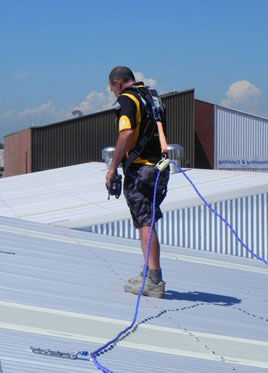Working at heights
For many trades, working at heights is all part of the job.
Whether or not you work at heights will also be a question asked of you when taking out insurance.
 Your answer can impact upon the cost of your insurance, or whether the insurer will even offer you cover at all.
Your answer can impact upon the cost of your insurance, or whether the insurer will even offer you cover at all.
Not all insurers treat all trades and all heights the same, so in this guide we’ll attempt to cut through some of the confusion.
Types of insurance affected
The main type of insurance affected by the heights you work at is public liability.
In some cases income protection / accident and illness insurance can be affected, but not always.
What is classed as ‘high’?
It’s a fairly loose term really, and whilst one tradie might think that working on the roof of a 3 storey building is high, another might think that’s low compared to the 50 level buildings he works on!
So what exactly does the insurer mean when they ask if you work at heights?
The good news is that most of them will specify the heights they are comfortable with.
For some insurers this is 10 metres, and for others it is 15 metres. These seem to be the industry standard figures across most insurers.
To give you an idea of how that equates to a real life situation, here’s a handy guide:
- 10 metres – covers most 3 storey buildings
- 15 metres – covers most 4 story buildings
- Over 15 metres – buildings more than 4 stories
Obviously there will be some exceptions, but if we are talking standard buildings, these guidelines should be quite accurate.
Internal or external heights?
Just because you’re doing the electrical work on level 60 of a city tower doesn’t necessarily mean the insurers will class you as working at heights.
It often depends on whether you’re working externally or internally, or whether or not you have a solid floor underneath you.
The specific wording here can vary from one insurer to the next, so it’s best to ask whether their definition of height relates to external work only.
Different trades
Your occupation or trade can have an impact on whether or not the insurance company will be concerned about the heights you work at.
For example one insurer asks painters about the heights they work at, but does not ask carpet layers the same question.
The rationale for this is quite obvious, as a painter is likely to be working externally on building, whilst a carpet layer is highly unlikely to be doing the same.
Cover for working at heights
Just because you work at heights exceeding 10 or 15 metres – even externally – does not mean that insurance is unobtainable.
In fact is doesn’t even have to be expensive or difficult to obtain.
Whilst the mainstream insurers will generally have height limits in place, there are specialist insurers who will cover work at unlimited heights.
Yes the cover will be a little more expensive, but not by a great deal, and it’s much better knowing that you’re fully covered by a suitable policy.
Working at heights with a policy that won’t cover you is simply not worth the risk.
When you request a quote from us we will ask about the heights you work at. All you need to do is answer the question honestly, and we’ll do the rest in finding you the right cover.


